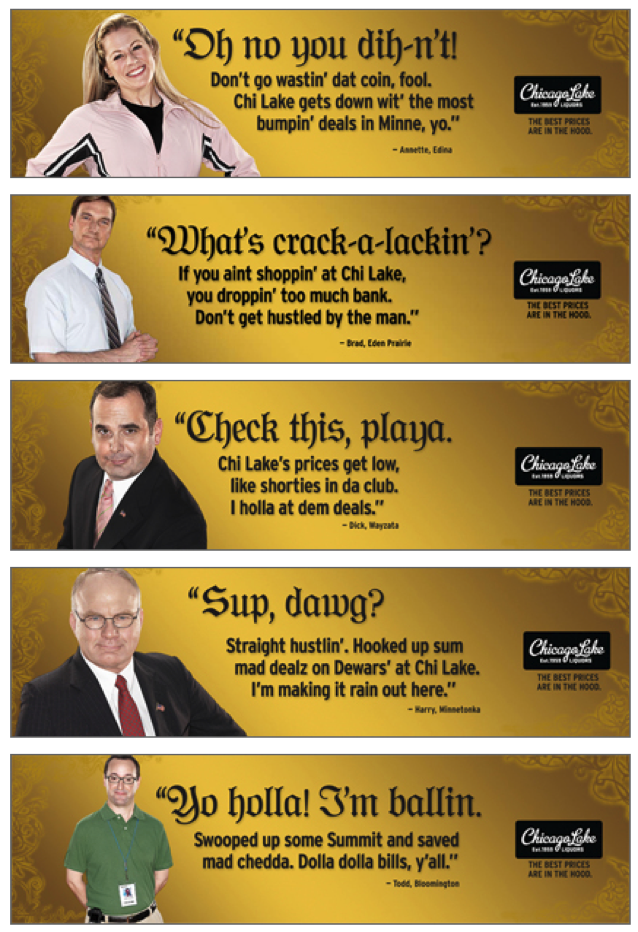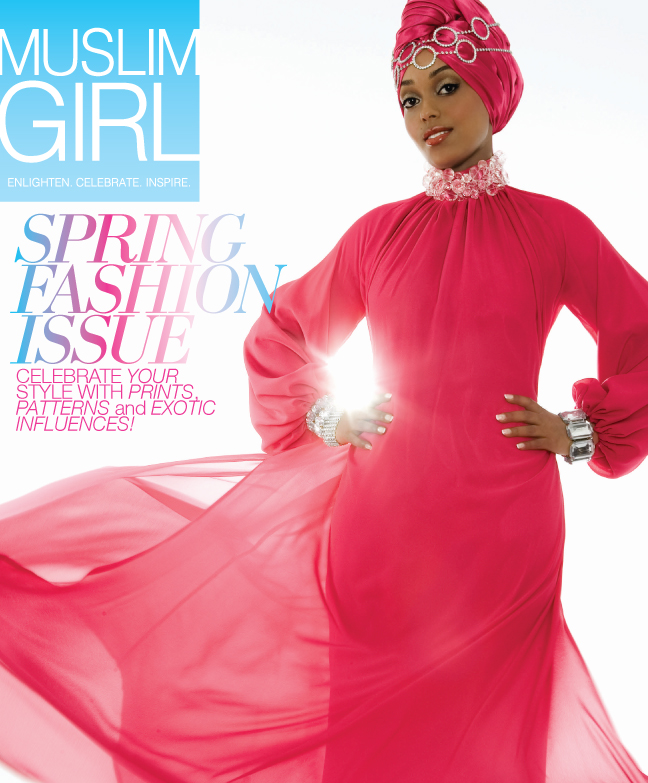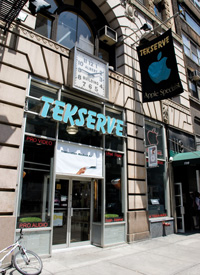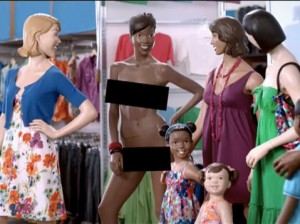
Is this series of billboards, above, coupled to a complementary set of commercials by the same company, below, racist?
Educate and excite, inform and infuriate.
July 16th, 2009 — Advertising, Media, Pop Culture, Race, TV

Is this series of billboards, above, coupled to a complementary set of commercials by the same company, below, racist?
July 3rd, 2009 — Internet, Media, NONFICTION, Technology
The day Michael Jackson died, it was a message on the social messaging service, Twitter, above, from TMZ head Harvey Levin that started the massive cascade of fear, grief, reminiscence, and adoration that ultimately swept the globe. Levin’s tweet, as Twitter messages are called, was a mere 77 characters in length, just a bit more than half the service’s maximum, 140 characters-per-message capacity. Rarely does such a small amount of text have such an immense, and rapid, effect.
Yet, whether in the death of a celebrity, or an uprising in a Middle eastern country—Twitter has been central, in terms of getting news out of that land, after their disrupted elections—the technology is making itself felt. In her new volume, The Twitter Book, co-written with O’Reilly Media founder Tim O’Reilly, Sarah Milstein talks about what Twitter is, how to get on it, and how to make it work for you. It’s a convenient to carry, easily-read book, just right for the neophyte, but with enough substance for power-users. Indeed, as the 21st person on the network—her boyfriend was an engineer with the young company—and a well-know consultant and author, Milstein definitely knows her stuff…and her Twitter.
Sarah Miltein is the guest today on my WBAI-NY / 99.5 FM radio show, NONFICTION, this afternoon, Friday, July 3rd, at 2 pm ET.
You can hear her ideas by tuning in at 2 pm. If you’re outside of the New York tri-state, check out our stream on the web. If you miss the live show, dig into our archives for up to 90 days after broadcast.
July 1st, 2009 — Black Music, Magazines, Media, Money
 Stick a knife in it, they’re done:
Stick a knife in it, they’re done:
Jay-Z unknowingly celebrates VIBE’s last Juice issue, September 2008
When I went upstairs yesterday, to the 21st fl. of 120 Wall St., and the offices of VIBE Media Group, I first noticed the seated retirees at the door. I suspected, and it was later confirmed, that they were security, sent by the company’s owners to maintain the premises as the magazine’s personnel began packing up their professional lives.
June 19th, 2009 — Media, NONFICTION, Radio, Religion, Science

The over 400,000 women, ages 18-24, in the U.S. and Canada who practice Islam have been dutifully represented, bimonthly since 2007, by Muslim Girl magazine, the only beauty and lifestyle publication that targets young females of the faith.
Unfortunately, the mag has not published an issue since this one, above, in the spring of 2008. As Ausma Khan, editor-in-chief, noted in a letter to readers on the Girl‘s web site, the causes are “the current state of the economy and the overall decline in the print industry,” but, also, uniquely, “an advertising industry that is risk-averse to our name and audience.”
I’m personally hoping that Muslim Girl will revive and thrive. Though neither a Muslim nor a girl, I found it an exciting, thought-provoking, and colorful read. Normally, this is the part where most would also probably say something about hoping we can one day live in a country where all people are respected, no matter what their religion, skin color, etc. However, I’m Black.
Magazine or no magazine, Ausma Khan is a smart and analytical thinker on many issues, and especially on ones muslim girls face. That’s why she’s a guest today on this repeat edition of my WBAI-NY / 99.5 FM radio show, NONFICTION, this afternoon, Friday, June 19, 2 pm ET.
 As well, I’ll be speaking with astrophysicist Dr. Janna Levin, right. (You may recall me mentioning her, last week, in my post on whether or not the universe is conscious and alive.)
As well, I’ll be speaking with astrophysicist Dr. Janna Levin, right. (You may recall me mentioning her, last week, in my post on whether or not the universe is conscious and alive.)
She’s giving a lecture here in New York, next week, Tuesday, June 23, 2009, 8:00 PM, at Columbia University’s Lerner Hall, as part of the 8th Edoardo Amaldi Conference on Gravitational Waves. Janna’s talk, Songs from Space: Black Holes and the Big Bang in Audio, will show how physicists are using audio, animation, and other aids to make the wonders of the cosmos more real to regular people. (Check out her cool poster.) Plus, we’ll be playing one or two weird-sounding samples from her talk, in advance, during the broadcast!
You can hear Ausma Khan’s and Janna Levin’s ideas by tuning in at 2 pm. If you’re outside of the New York tri-state area, you can check out our stream on the web. If you miss the live show, fly over to our archives for up to 90 days after the broadcast.
May 4th, 2009 — Entertainment, Film, Media, TV
At MEDIA ASSASSIN, we work to make our heds particularly catcy, but, in this instance, need any more be said? It’s Crispin Glover on Happy Days!
I know what you’re thinking: Crispin Hellion Glover, the actor whose note-perfect George McFly in 1985’s Back To The Future broke him out—and whose subsequent appearances on Late Night with David Letterman and in the ratfest remake Willard (here, he sings Michael Jackson’s “Ben”) weirded audiences out—was on Happy Days?
Yep. In November 1983, the seventh episode of the 11th and final season—long after Happy Days had both literally and figuratively jumped the shark in September, 1977—Glover appeared as truant Roach in the series’ “Vocational Education” piece.
Crispin Glover! Not even the fact that he’s sharing the scene with noted “series killer” Ted McGinley as Roger, the school principal, dilutes the joy of this.
April 29th, 2009 — Film, Media, Military, Pop Culture, Science-Fiction

As I mentioned in yesterday’s post, when I spoke with Clive Young in March on NONFICTION, my radio show, I referred to a Star Wars fan film I’d seen of whose name I was not sure. I thought it was The Way of the Saber, but had to research it.
As it turns out, I was mostly correct: The 6-minute short, 2002’s Art of the Saber, by brothers Calvin, Clarence, and Cary Ho, employs the basic phoneme of SW fan film language—two men locked in light saber battle—invigorating it with flashy martial arts. But as opposed to then rehashing tales of Darth Vader  and Luke Skywalker, the Ho brothers, instead, frame their somber work with the words of Union soldier Captain Sullivan Ballou’s famed 1861 letter to his spouse, Sarah.
and Luke Skywalker, the Ho brothers, instead, frame their somber work with the words of Union soldier Captain Sullivan Ballou’s famed 1861 letter to his spouse, Sarah.
One of the most captivating documents to come out of the Civil War, the note is powerful for the beauty of its prose, the depth of its feeling, and that its author, writing in noble contemplation of sure death, never saw his wife and children again. Ballou, above, 32, was cut down at the First Battle of Bull Run within a week of writing the text.
By drawing from Ballou’s pathos, the Ho brothers imbue their piece with the Captain’s sober dread, forging a story that is both new, timeless, and a powerful meditation on the cost of war.
April 22nd, 2009 — Black Music, Entertainment, Hip-Hop, Journalism, Media, Race
I don’t know how, until this very morning, I missed the April 15 New York Times profile of white rapper Asher Roth by former VIBE music editor Jon Caramanica. (“To Be Young, Rapping and White,” it was near sacrilegously titled.) But it was certainly worth the wait.
April 16th, 2009 — Animation, Design, Film, Media
It’s common knowledge that, after masterpieces like Sleeping Beauty, Snow White, Fantasia, and other features, Disney animated films kinda went into the toilet. This was particularly true in the 1960s and ’70s, as the studio turned out uninspired crap like The Fox and the Hound, The Aristocats, and more.
However, what’s not been truly clarified, at least until now, is how demoralized the company had to be by the rampant cost-cutting at the studio during that time in order to do this: Create new films by merely retracing sequences from their old ones.
The (apparently French) editor of this short YouTube clip, above, has clipped shots from a number of Disney animated works, like The Jungle Book. Comparing them, he shows that animators of that era were not inspired by their past works, but merely sampling them: Literally redoing their cues with new characters.
Blecch. Thankfully, Disney Animation has since been taken over by Pixar, a company which it owns, and whose track record for storytelling and image quality are pretty much unchallenged. (Reportedly, they also treat their talent well. Disney had a reputation for mismanaging their work staff that, even into this century, was widely known.)
But what the Mouse’s House has made clear is that their problem was never a “2-D vs. 3-D” one. Their problem was imagination, and creating an environment in which it thrived. Sadly, the skills it takes to make that flourish can’t be copied from a movie, literally or otherwise.
March 26th, 2009 — Hip-Hop, Media, Music, Technology
Why did hip-hop succeed?
That’s probably the first question I’m going to be asking tonight at the free Future of Music 4: The Rise of Hip Hop and its Influence on Other Media panel, 8:30 pm, at Tekserve (119 W. 23rd St., bet. 6th & 7th Aves.; 212-929-3645), New York City’s premier Apple retail and repair store. My job is moderating a discussion between DMC, aka Darryl McDaniels of Run-DMC fame; the pugilistic Freddie Foxxx, aka Bumpy Knuckles; and Troy Hightower, of Hightower Productions, the renowned audio engineering firm. I’m expecting a rich convo from this power-packed trio.
 Some background about “Future of Music”: We’ve been hosting these events at Tekserve, right, more or less bimonthly, as of this year. The turnout’s been consistently excellent, and I’ve been having a fantastic time with the folks there. Tekserve’s a great shop to roll through, ask questions, or just see the latest toys. It’s a friendly, helpful kind of establishment, of the sort that you don’t see a lot anymore, especially around anything having to do with computers. Hey: I’m not just president of the panels we do: I’m a client. In fact, every post I’ve ever written for MEDIA ASSASSIN, including this one, was created with a PowerBook G4 12″ that I bought at Tekserve four years ago, and it’s still clicking along. Consider me one of the faithful, as I expect we’re gonna meet, and make, more tonight.
Some background about “Future of Music”: We’ve been hosting these events at Tekserve, right, more or less bimonthly, as of this year. The turnout’s been consistently excellent, and I’ve been having a fantastic time with the folks there. Tekserve’s a great shop to roll through, ask questions, or just see the latest toys. It’s a friendly, helpful kind of establishment, of the sort that you don’t see a lot anymore, especially around anything having to do with computers. Hey: I’m not just president of the panels we do: I’m a client. In fact, every post I’ve ever written for MEDIA ASSASSIN, including this one, was created with a PowerBook G4 12″ that I bought at Tekserve four years ago, and it’s still clicking along. Consider me one of the faithful, as I expect we’re gonna meet, and make, more tonight.
So, first I’ll talk with the panel: What is the source of hip-hop’s influence? How has it affected the media we consume? Where do we see the greatest resistance to its clout, and what is at risk where it is denied? Then we’ll take questions from you, our always-curious audience. The issues are serious, the talent is legendary, and you rarely get to just ask these guys questions, so represent.
March 23rd, 2009 — Advertising, Fashion, History, Media, Race
So wrote Leroy Colson of Detroit MI this past Friday, in an e-mail to MEDIA ASSASSIN. The Lord and Taylor ad to which he refers, above, shows two models wearing pink, $150 Ellen Tracy trench coats.
Well, rather, one of them—the white one facing the camera—wears the coat. The other one—the Black one with her back to you—can’t help flashing a white man walking by with two dogs, both of which, if you look closely, have their eyes punningly trained on her putty-tat. The auburn-colored chow is even tugging like he’s gonna run after it.
 Colson tipped me to this image after he read this past Thursday’s post, “Are There Racists at Old Navy, or Do They Think That We’re Dummies?” That piece described what I perceived as the underlying racial code of the current Old Navy “Mid-Town Flash” commercial.
Colson tipped me to this image after he read this past Thursday’s post, “Are There Racists at Old Navy, or Do They Think That We’re Dummies?” That piece described what I perceived as the underlying racial code of the current Old Navy “Mid-Town Flash” commercial.
It’s the one in which a Black store mannequin, above right, has her dress ripped off, leaving her, except for matching black bars, naked before her co-mannequins, as the incident is played for laughs, including her own.
Exactly what are the chances that a random individual, reading an article critiquing the public racial display of the nude Black female body, would, that same day, be sent another, unrelated ad, also racially displaying the nude Black female body in public? (By racial, I mean anything said or done that involves white people with non-white people.)
Maybe the chances are high. Perhaps having noticed such an ad, a viewer’s heightened attention might readily be drawn to another different one. But, hey: Are there that many of these around? Is this a sub-category? I mean, we’re not talking about something akin to the millions of spreads featuring pictures of, say, mothers gently feeding their babies, here, right?
 Oops: I spoke too soon, suddenly recalling clothing maker Benetton’s notorious 1989 ad, right, something the company called part of its “campaign for equality between black and white,” proudly noting that, while controversial, it “represents the most-awarded image in Benetton’s advertising history.”
Oops: I spoke too soon, suddenly recalling clothing maker Benetton’s notorious 1989 ad, right, something the company called part of its “campaign for equality between black and white,” proudly noting that, while controversial, it “represents the most-awarded image in Benetton’s advertising history.”
Clothing, white customers, Black women’s bodies: There’s almost something antebellum about the mix. How much of this sort of advertising exists? Why does it? Why does it always involve a Black woman being eyed by a white man—or in this case, suckling one—but never the reverse? I’m just asking those questions rhetorically. I’m Black, and, like Thulani noted in her comments, I know that
If a black kid had ripped the dress of a “white” mannequin, it would have [been] read as hostile in a racial way but it would not evoke many similar images from the past– there is no tradition of exposing white women’s bodies on the slave block. [Eds. note: Though, clearly, the slave block and suckling white infants are deeply intertwined.] … If the company meant to imply that the dresses were so cute the customers were ripping them off the mannequins, having them all ripped would have made the point in a non-racialized way.
In other words, there’s a relationship between what’s not permitted in reality and what’s not permitted symbolically, and the reverse is also true. Which was my original point: I believe the line from the auction block to the display stand is unbroken.
So, while I can’t prove they’re directly related, for example, it’s not odd to me that, that, in a country which tends towards these kinds of displays, a 2000 Congressional report found that “Black women were nearly twice as likely to be strip-searched on suspicion of smuggling drugs as white men and women.”
In any event, it’s fascinating the response last week’s post provoked. Besides the comments, perhaps the best indicator of the nerve it hit is that, on the day it went out, twenty of the people following me on Twitter quit doing so. (My followers automatically get tweets linking them to each day’s new MEDIA ASSASSIN post.)
Twenty is far more than have ever canceled me in one day. (The highest before that was seven.) In fact, twenty is more than half of all my Twitter unfollows to-date. Hopefully, most of them will come back when they see this post.